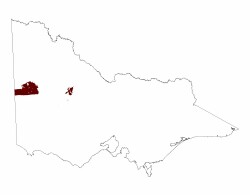5.5.1 Prominent ridge tops with remnant aeolian sands and oriented swales with lakes and lunettes (north of Little Desert)
5. North Western Dunefields and Plains (DP)
5.5 Ridges with sand, and flats (Goroke, Nhill)
| This unit is located in western Victoria, clearly bounded by the Little Desert to the north and the Low Plateaux (Dundas Tableland) to the south. The South Australian border is the artificial western boundary and the Wimmera River Valley (Lowan Salt Valley) and the Douglas Depression comprise the eastern boundary. This unit is dominated by a series of parallel and sub-parallel ridges orientated NNW/SSE, interspersed with similarly aligned valleys or swales. This pattern is still discernible in the siliceous dunefield units (5.2) to the north. This landform pattern is not as distinct in this unit compared with north of the Little Desert, with the relative relief of the ridges ranging from 10 m. The ridges have an amplitude of 2km and slopes up to 5%. The intervening valley floors may extend to plains in the west (Apsley) and nearer the eastern boundary. These valley floors are dominated by lagoonal deposits, which can be quite shallow as well as the many lakes, swamps and depressions. The ridges consist Parilla Sand (Tpp), ferruginised at the surface which are exposed on the larger ridges, while Lowan Sand Formation (Ql), siliceous sandy material covers most of the smaller ridges and adjoining slopes; a result of reworking of the Parilla Sand. The valley floors have younger lagoonal deposits(Qrs) consisting of expansive (cracking) dark organic clays, which may be quite shallow at their edges as well as some texture contrast soils on alluvial rather than aeolian deposits. |  |
Sandy surfaced sodic texture contrast soils (Sodosols) and sandy soils (Rudosols, Tenosols) generally acidic occur on the Parilla Sand exposures and the Lowan Sand terrain, while sodic (Sodosols)and non sodic texture (Chromosols) contrast soils occur on the smaller ridges and lower. Grey and black cracking clay soils (Vertosols) formed on lagoonal deposits dominate the swales and valley floors.
Sheet erosion is relevant to any sloping terrain with water repellancy as an associated issue in this unit. Wind and gully erosion is a land degradation issue particularly relevant to the larger ridges. Water repellency is an issue on the sandy surfaced soils with some organic mater soils particularly where surface soil horizons are shallow. Waterlogging may be an issue on the valley floors depending on rainfall events, as rainfall increases southward.


